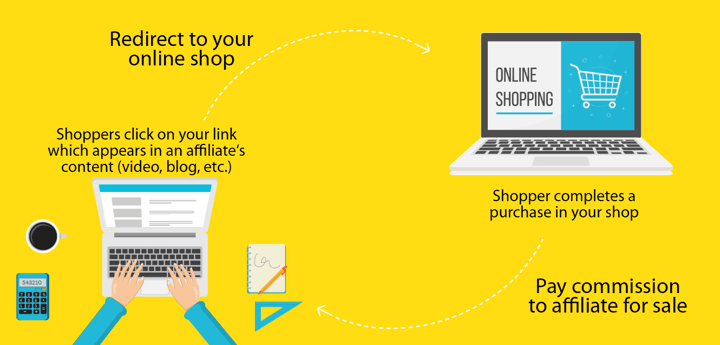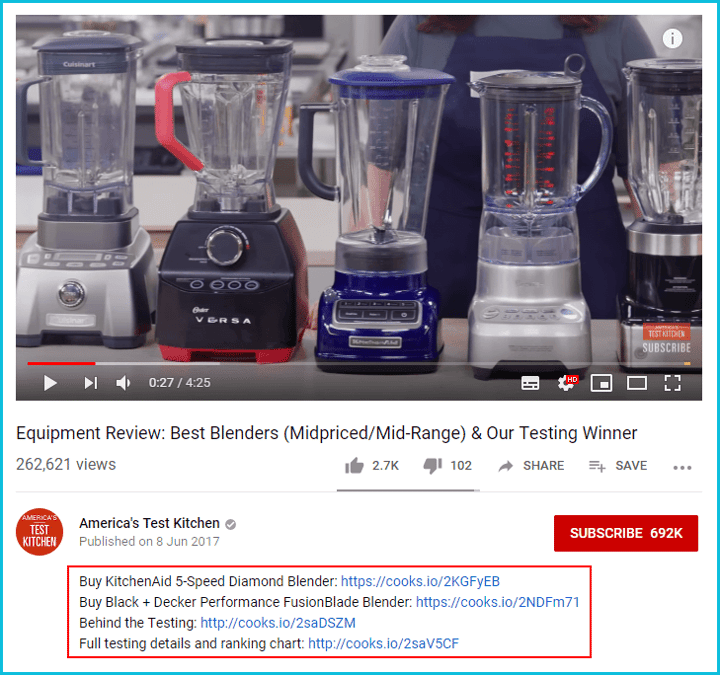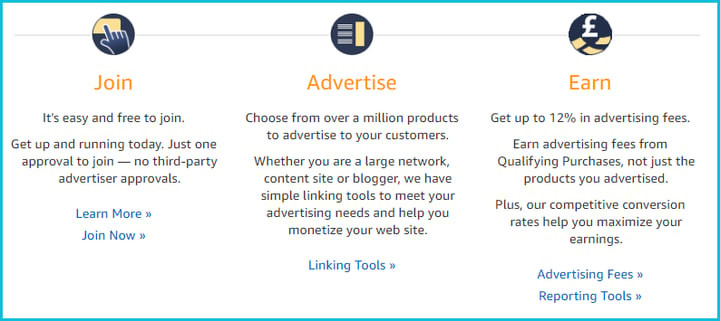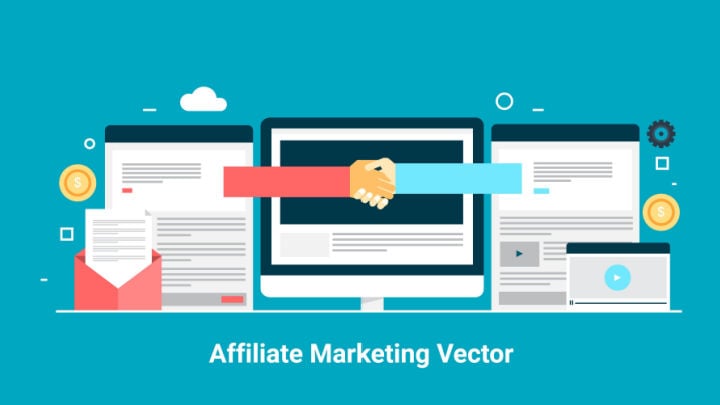SEO Tips for E-commerce: Improve Your Online Shop's Ranking in Google
SEO is an important tool for e-commerce businesses to bring in new customers. Here are the best tips for your online shop to rank higher in Google.

Affiliate marketing is a concept that can be a little vague and cause some confusion. However, if you are looking to acquire new customers, gain more traffic, develop your sales or generate leads, it is definitely worth taking a closer look. How does affiliate marketing work? How do you get started? And what are the best methods to use? Keep reading to find out!
In case you want to skip ahead to any particular section:
Table of Contents:
Affiliate marketing is a system based on cooperation between a merchant (advertiser) and affiliates (marketers / publishers).
You can think of affiliate marketers (a.k.a. affiliates) as a kind of modern-day sales representative. They are responsible for promoting and, above all, selling your products in exchange for a commission (usually a percentage of sales).
In concrete terms, you provide affiliates with various promotional materials with trackable links (through a cookie system) and they are responsible for promoting your products and redirecting their audience to your site.
You, as a shop owner/seller, can benefit from targeted traffic composed of internet users that are already convinced of your products and ready to complete their purchase.

In other words, where do your promotional materials appear? Who shares the links to your online shop?
One of the most typical examples of affiliates are content creators who have gained a loyal audience in a specific niche. Think about YouTubers, blog writers, or social media influencers.
Typically, they will create some content (e.g. unboxing video) and include links to that product in the description. If viewers click on the link and buy the product, the affiliate will get a commission from the seller.
As was mentioned above, you have the choice of collaborating with influencers. They might include links in their blog articles, for example, or if they do not necessarily have a website, they will then promote your products through their social media accounts like YouTube or Instagram.
Taking YouTube as an example, they will reference your affiliate links in the descriptions below their videos or provide links in the videos themselves, as in the example below:

In this example, the channel "America's Test Kitchen" reviews a few blenders and provides links to some product pages in the description below the video.
It's important to note that affiliate marketing isn't necessarily the same as influencer marketing.
If you do not wish to work with influencers, you can advertise on websites specialising in affiliate links.
In fact, some websites exist solely for the purpose of affiliate marketing. When you visit a site full of ads (and I'm sure you've already done that), there's a good chance that their owners will generate a large part of their income through affiliate links.
Moreover, if your site is suitable, you can also consider becoming an affiliate marketer in order to earn some extra income.
Another example would be… Amazon, of course!

Click on the following link to find out more about Amazon Affiliate Marketing
In fact, if you want to know what a site entirely dedicated to affiliate partnerships looks like, I suggest you take a look at thisiswhyimbroke.com.
Although the website connects to the US Amazon site, it remains a good example of what a site specialising in affiliate marketing is, in particular, affiliation through the Amazon Affiliate Program in this case.
Now that you know a bit more about affiliate marketing, you might ask yourself...
How do I find affiliates and set up affiliate campaigns?
If you are embarking on the affiliation adventure, the easiest way to get started is to use an affiliate platform.
With their vast network of affiliates, a good platform will take care of finding the editors and programs that best suit your needs.
To integrate into their networks, publishers must have a minimum amount of monthly traffic and be able to adapt to advertisers' themes.
And that's not all. One of the other advantages of using a platform is of course their interfaces.
In addition to simplifying technical exchanges with affiliates, they give you an overview of your campaigns, provide you with activity reports and key performance indicators (KPIs).
In short, they provide you with everything you need to analyse your campaigns.
Once you embark on the affiliation adventure, you might ask yourself a thousand different questions. For example:
The advantage of using a platform is the structure and professionalism they offer.
In short, the seller offers their affiliate program, the platform connects them with affiliates, manages the program (i.e. statistics, tracking, payments), and the affiliate recovers everything that can be used to promote your products, track their sales and recover their commissions.

Shutterstock/Sammby
Awin is considered one of the biggest affiliation platforms in Europe and is definitely an industry leader.
Clickbank is also well-known. It is an international platform, so it is a good choice if you are selling abroad.
Affilae is also relatively famous in the industry. It is considered quite easy to use.
Of course, there are plenty of options online, so do your best at finding a platform that matches your needs and goals.
If you use an affiliation platform, it is pretty normal to pay an entrance or membership fee. The latter can often vary according to the size of your online shop.
In some cases, you can get a free trial period.

Shutterstock/eamesBot
If you end up subscribing, you'll then have to pay a commission to the platform. The affiliates get paid as soon as one of the set objectives is reached (e.g. a sale, a lead, a click).
When it comes to the payment of affiliates, you generally only pay for concrete results, which naturally also depend on the objectives you agree upon (more on that below).
Just remember that even though a lead or a click might not lead directly to a sale, having that contact in your system could eventually lead to a sale by other means (e.g. retargeting efforts).
Either way, controlling these objectives allows you to keep control of your ROI.
As payment to your affiliates can depend on the goals you set for your campaign, let's see exactly which objectives you can use.
This is the most common method. Each sale is subject to a commission. This can be a percentage of the basket amount, the item, or a fixed amount.
The commission can vary greatly depending on the product category (from about 10 to 50%).
Be careful not to offer commission rates that are too low: your remuneration must be attractive and correspond to that of your competitors.
Each lead (which might include each subscription to a newsletter, request for quotation, participation in a competition, etc.) earns the right to a commission.
However, this type of remuneration remains a little risky: some affiliates generate fake registrations in order to improperly increase their results (and get paid more).
To compensate for this, you can set commissions per qualified lead. This means that the generated lead corresponds to a real potential customer that fits your customer persona. How you qualify those leads is up to you, but generally, there will be some criteria that the registrations need to fulfil from a data perspective (e.g. age, job title, gender, etc.).
As soon as an internet user clicks on your promotional link, the affiliate receives a commission.
This CPC payment form can be compared to the way Google Ads works, in that the click is what costs you, not the conversion.
This method of remuneration is definitely not the most popular and unfortunately allows you less control over your ROI.

Shutterstock/igor kisselev
Nowadays, advertisers generally provide all the materials that affiliates may need. This may include:
These banners and images often include an animated GIF or some promotional images. They may, for example, use the banners of an ongoing promotion.
You simply provide a text with a link that may appear in different locations according to the different social platforms the influencer uses.
This is information about the highlighted product: labels, prices, descriptions and links to the product page that you provide to the affiliate as a CSV or XML feed.
You can also benefit from the affiliate's database. It will then be up to you to write part of or all of the email.
You create an exclusive or non-exclusive promotional code, which your affiliate's audience will use to buy on your site.
Behind each promotional channel mentioned above, there must be a link to a product page or a landing page. As an alternative to a promotional code, you can build a special landing page for that specific audience (e.g. "Visit demoshop.com/mypodcast to get this exclusive discount!").
As an alternative to using special affiliate platforms or agencies, you can get in contact with your affiliates directly.
For your information, Amazon only uses direct affiliation.
Keep in mind that you will have to manage each of your campaigns independently, whereas affiliate platforms offer you a comfortable interface, some KPIs, and daily reports.
If you are just starting with affiliate marketing, choose your affiliates with care. Take the time to find the ones that best match your products (and audience) and whose seriousness and professionalism are recognised.
Not all publishers take their mission to heart and some are satisfied simply spamming the web with your affiliate links.
If you choose to work with influencers, choose producers of quality and high value-added content (i.e. videos, blog articles, etc.).
You should only partner with scrupulous and selective editors. They are the ones who will best highlight your products, your image, and obtain the best results.
In addition, they already enjoy the trust of internet users and, as you probably know, their trustworthiness and confidence are essential to the success of these types of campaign strategies.
However, there is nothing to stop you from cooperating directly with your key affiliates after working with affiliate platforms first.
You will be effectively getting rid of the middle man, which will save you money. This will strengthen your partnership and may even attract new publishers.
Cashback certainly isn't new, but it has been talked about more and more recently. It should, therefore, definitely be considered for your affiliate strategy.
This principle is based on reimbursing the customer a certain percentage of the value of their purchase.
Just like "classic" affiliation, there are some specialised platforms for cashback, with the difference being that it is the end customers who have accounts on these sites and not the affiliates.
In concrete terms: a customer buys a product from one of the partner merchants via the cashback platform. In return, the latter makes a partial refund of the amount of its purchase.
This is generally a refund of 0.5 to 5%.
This can also take the form of a fixed refund (such as £10 refunded from a £50 purchase), or discount vouchers and discount codes.
In fact, the cashback platform simply returns a portion of the commission received by the merchant partner back to the customer.
In the UK, the main cashback sites are Quidco, TopCashback, and Swagbucks.
Whatever form you choose, there is always a clear benefit in using affiliation marketing. Take good care when deciding on which influencers and platforms you choose to go with. Also, don't hesitate to create a special landing page for any affiliate campaign.
This article was translated and adapted from our French blog: Affiliation : Plateformes, Cashback - Tous nos conseils pour réussir votre campagne marketing
17/02/21SEO is an important tool for e-commerce businesses to bring in new customers. Here are the best tips for your online shop to rank higher in Google.
Valentine's Day has grown in popularity across Europe. We're sharing some romantic statistics (redundant, right?) and look at 9 marketing tips for V-day.